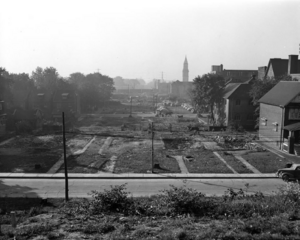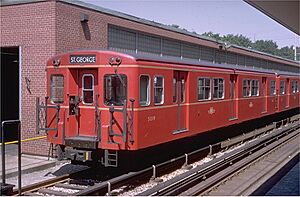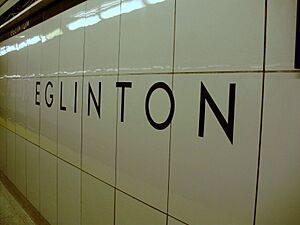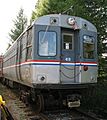Yonge-University-Spadina (TTC) facts for kids
Quick facts for kids Yonge-University-Spadina Line |
|
|---|---|

A subway train waits for passengers at Bloor-Yonge station.
|
|
| Overview | |
| Owner | Toronto Transit Commission |
| Locale | Toronto, Ontario |
| Termini | Finch Downsview |
| Stations | 32 |
| Service | |
| Type | Rapid transit |
| System | Toronto subway and RT |
| Operator(s) | Toronto Transit Commission |
| Rolling stock | RT75 T1, RT75 H5 |
| History | |
| Opened | March 30, 1954 |
| Technical | |
| Line length | 30.2 km (18.8 mi) |
| Track gauge | 58.875 |
The Yonge-University-Spadina Line is the oldest and busiest subway line in Toronto, Ontario, Canada. It is run by the Toronto Transit Commission (TTC). This subway line has 32 stations and is about 30.2 kilometers (18.8 miles) long. It first opened in 1954. Over the years, new stations were added in 1963, 1973, 1974, 1978, and 1996, making it longer and more useful for people in Toronto.
Contents
How the Subway Runs
The Yonge-University-Spadina Line runs almost every day. From Monday to Saturday, trains operate from around 6:00 a.m. until 1:30 a.m. On Sundays, the subway starts a bit later, at 9:00 a.m., and also runs until 1:30 a.m.
How Often Do Trains Come?
During most of the day, a subway train comes every 4 to 5 minutes. This means you usually don't have to wait very long! During busy times, called rush hours, even more trains are added. This makes the wait time shorter, usually only 2 to 3 minutes between trains.
What Happens When the Subway Closes?
When the subway closes late at night, the 320 Yonge bus takes over. This bus follows the same route as the subway line, making sure people can still travel even after the trains stop running for the night.
History of the Line
Building the Yonge-University-Spadina Line was a huge project for Toronto. It was the first subway line in the city and a big step forward for public transportation.
Early Construction Methods
To build parts of the subway, workers used a method called "cut-and-cover." This meant they would dig a big trench (a "cut") in the ground, build the subway tunnel inside it, and then cover it back up. Sometimes, homes and buildings had to be moved or taken down to make space for these large construction areas.
What Did the First Trains Look Like?
When the subway first opened, the trains were called Gloucester (G-series) trains. These were the first trains used on the system.
The TTC had thought about using trains that were more like streetcars, but they decided on the Gloucester trains instead.
Station Design
Some of the older stations had special walls made of Vitrolite tiles. These shiny, colored glass tiles were popular for a while. Today, Eglinton station is one of the last places where you can still see these original Vitrolite-tiled walls.
Images for kids
-
The TTC intended the subway to use streetcar-derived trains, like this former Chicago 'L' train preserved at the Halton County Radial Railway
See also
 In Spanish: Línea 1 Yonge-University para niños
In Spanish: Línea 1 Yonge-University para niños










